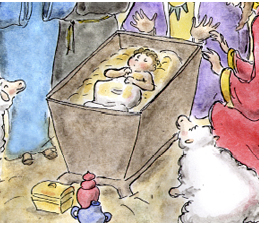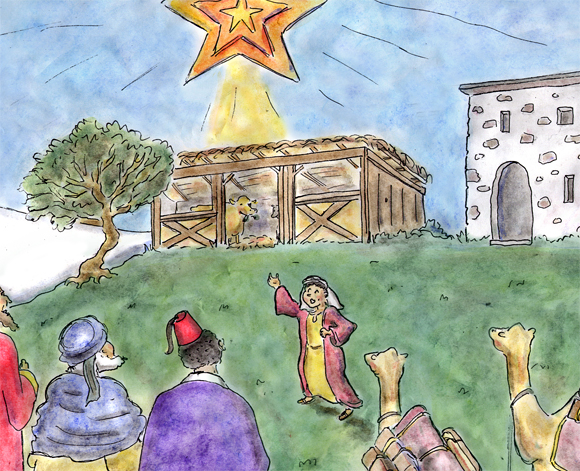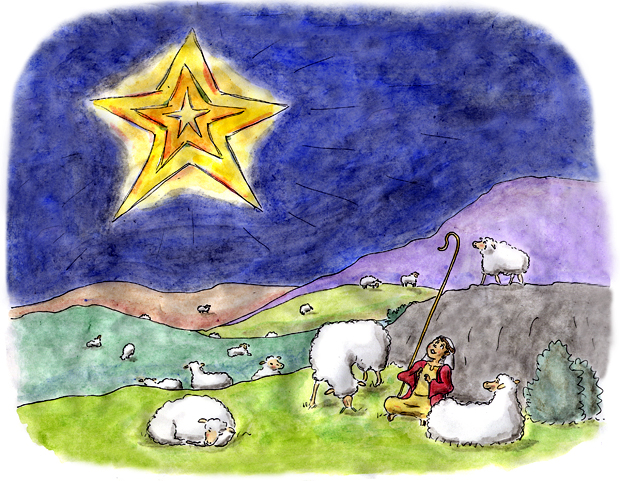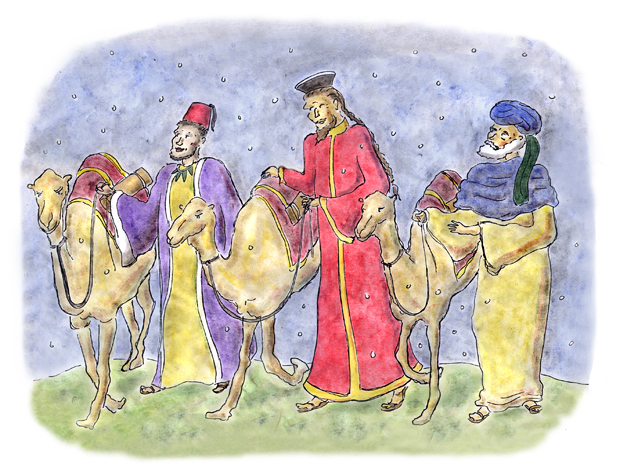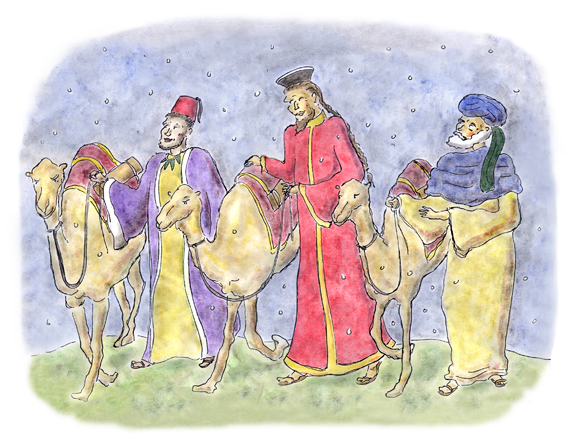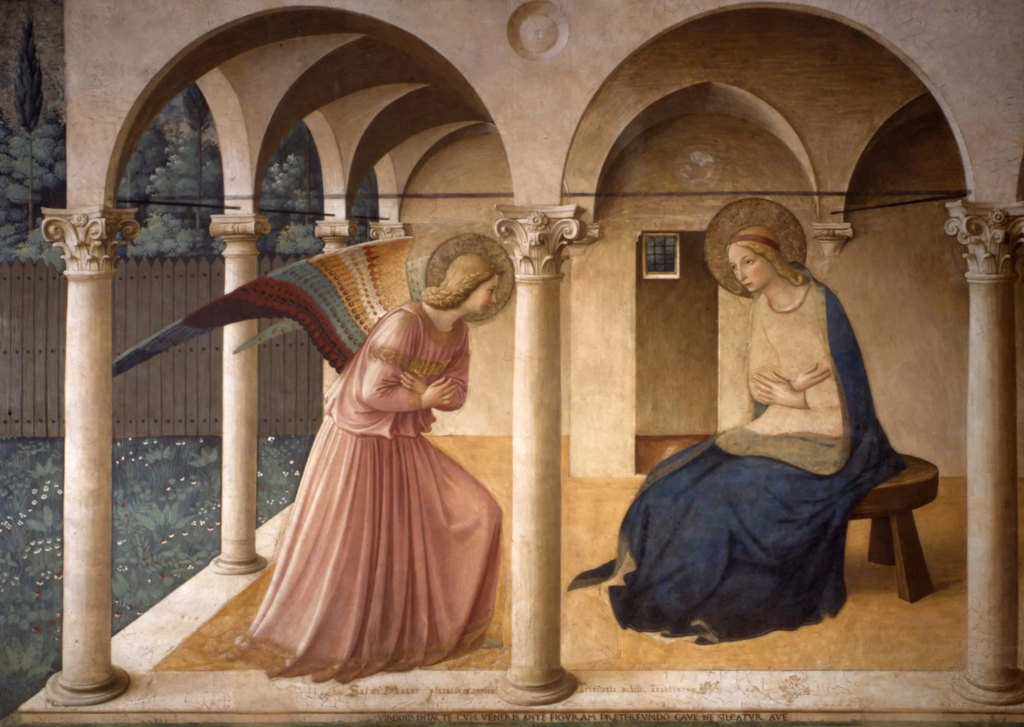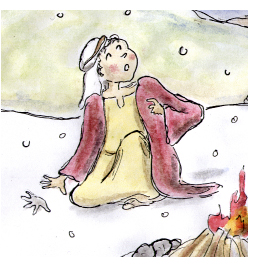
MUSIC
Jesse's Song
If you've shared Star of Wonder about the young shepherd who saw the star and led the way, "Rise Up, Shepherd, and Follow" would be a fun song to follow up with, but it's great fun no matter what! It's an American folk song, easily found online at such places as hymnsite.com (music and lyrics), or on YouTube (videotaped performance).
Star caroling
As the children learn the song, consider having them actually play follow the leader: Put a star on a stick to lead the way, with the children passing the star along after each refrain so everyone gets a chance to be the leader. This tradition of gathering in groups to follow a star while singing Epiphany carols is called "star caroling." Make your star caroling as lively and festive as you like; consider having an adult as the first leader, setting the stage for creative adventuring by taking the children over and under furniture as they follow the star.
Shepherd Costumes
Because Epiphany is a holiday with a tradition of performance, consider having the children make easy shepherd costumes using extra-big t-shirts or pillow cases with arm holes, tied at the waist with a scarf, necktie, or other length of fabric. Then when they parade around singing "Rise Up, Shepherd, and Follow" they'll look like a band of shepherds and shepherdesses.
Royal costumes and caroling
In honor of the Three Kings, those three strangers that Jesse welcomes, you could also teach the children "We Three Kings" and use the same star to lead the way on another costume parade. If you aren't sure of words or tune, you can see it sung here, with printed lyrics or look at Jennifer Avalon's video. To turn shepherds into kings and queens, have each child make a crown, and then, for a royal robe, tie or pin a towel over the shoulders, or make simple capes out of scraps of fabric, held together with snaps, velcro, or pins. Once again pass the star around so the children get to take turns being the leader.
Combined caroling
Another option is to have the children choose one costume to create, and have a parade of both shepherds and royalty as the children parade from room to room—even outside if the weather is good—singing both songs alternately
House Blessing
Since Epiphany used to be one of the holidays when families would bless their homes, you might consider closing the parade with a blessing of each room in your home, stopping for the children to give thanks for the good things that happen in each space. Weather permitting, you could conclude by circling the outside of the house or apartment building, still following the star, singing the Doxology as a way to bless the place:
Praise God, from whom all blessings flow;
Praise God, all creatures here below;
Praise God above, ye Heavenly Host;
Praise Father, Son, and Holy Ghost. Amen.
(For those like me who can't actually sing, star caroling may be more of a "joyful noise" than what anyone would call "music," and I admit that I usually stick with "We Three Kings" because it's more familiar, but it can still be fun, and as children learn the words and tune, their voices will carry you along.)
Praise God, all creatures here below;
Praise God above, ye Heavenly Host;
Praise Father, Son, and Holy Ghost. Amen.
GAME and OTHER ACTIVITIES
For a family game, you could have the children play "Journey of the Magi" by taping a star to the wall, blindfolding them one by one, spinning them gently, then seeing who ends up closest to the star (hence the Holy Family). The child who comes closest to reaching the star could then be the first to lead the star caroling (or the second, if you want an adult to begin).
Marking the door
Another Epiphany activity is to decorate your front door with the initials of the three kings sandwiched between the numbers of the new year, for example 20 + C + M + B + 13 for 2013. The initials of the magi—Caspar, Melchior, and Balthasar—also represent the motto "Christus mansionem benedicat"—or, "May Christ bless this house." If marking the door doesn't work for you, children can write on the sidewalk or street out front.After the children finish decorating the door, you can say the words, "May Christ bless this house," or you could do a more formal house blessing.
Marking the door
For additional ideas to help celebrate Epiphany, visit theworshipwell.orgFOOD and PLANS FOR A FESTAL MEAL
FOODS OF THE SEASON
Because Epiphany celebrates Jesus' manifestation to the whole world as represented by the Three Kings who came from different continents and cultures, a festive Epiphany meal should include a variety of foods from around the world. Select a few easy recipes for ethnic dishes that the children could help prepare.
Snack: curried peanuts
One easy—and happily noisy—snack you might try is curried peanuts: just pour a jar of dry roasted peanuts into a paper bag, add a teaspoon or so of curry, and have them take turns shaking the bag. (If the children find the taste too strange, suggest that they each put a small amount in a plastic baggie, tie it with a pretty ribbon, and give it as an Epiphany present to a favorite adult.) For older children you might try a more sophisticated recipe that involves some frying.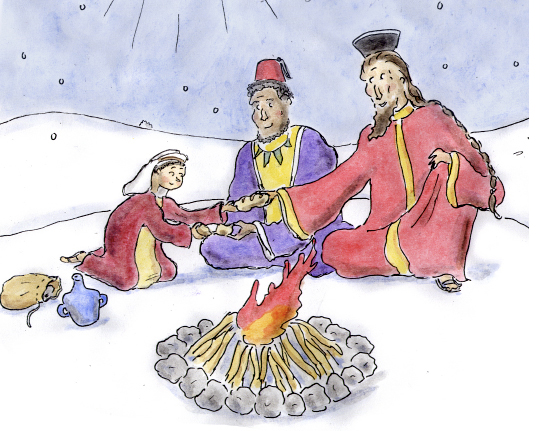
Soup: peanut butter soup
Make an easy version of peanut butter soup from West Africa (simply blend of one cup peanut butter, one cup milk or cream, and four cups of chicken or vegetable broth, flavored, if you like, with sautéed onions and cayenne pepper). Or try a traditional butmore complex African chicken and peanut stew.Main course: stir fry
Help the children prepare a Chinese stir fry. If they're too young to help cut up vegetables, you can use already cut-up frozen vegetables such as carrots, broccoli, cauliflower, sugar snap peas, and whole green beans: have the children put them in a strainer and run hot water over them for a minute, drain well, and pat dry with paper towels. Stir fry the vegetables quickly in a frying pan or wok, adding cut up meat, poultry, or fish if desired; season the dish with soy sauce, garlic, ginger, and a little honey. Top the stir fry with sprouts if you like, and serve with rice. Another easy stir fry recipe can be found here. Or, for vegetarians, try a simple recipe for tofu and vegetable stir-fry with ginger.Bread: crescent rolls with hidden messages
Adapt the Chinese fortune cookie idea by rolling up lines from Scripture or from Epiphany carols or other simple messages inside crescent shaped dough. Some sample fortunes are:* "You are the light of the world"Type the messages and cut them into strips. For the dough, you can use your favorite bread recipe, frozen dough, or refrigerated crescent dough in a tube.
* "Follow your star"
* "God's angels are with you"
* "Take delight in the Lord, and you shall have your heart's desire"
* "Arise, shine, for your light has come."
If you start with the tubes of crescent roll dough, follow the directions for separating the rolls, brush them with butter, then place the folded messages at the wide end of the triangles, then roll them up, starting at the wide end; bake as directed on the package.
Working with homemade or frozen (defrosted) dough, roll it out into circles about one quarter inch thick, brush it with melted butter, cut the circle into 8 or 12 triangles, fold the typed messages in half or thirds and place them at the wide end of the triangles, then roll them up, starting from the wide end. Curve each roll into a crescent moon shape. Preheat the oven to 375 degrees. Place the rolls on a greased cookie sheet, let rise for 20 minutes, then bake until nicely browned, about 15-20 minutes.
Dessert: Epiphany cake, sometimes called a King Cake
For a basic version, use any spice cake recipe baked round, either in a tube pan or two round layer cake pans, topped with a dairy-based frosting: whipped cream, cream cheese, or sour cream. Or you can try a French version, or a Spanish "King Cake."It's traditional to bake a dried bean—or an almond—into the cake, and the one who gets the bean is then hailed as King or Queen. Besides being given a paper crown to wear, the King or Queen can be the first to name the best blessings of the past year—a nice way to close the meal, with everyone naming blessings.
This meal includes foods from the three continents of the Kings: Africa, Asia, and Europe—but feel free to experiment with plenty of other ethnic dishes as well.
Decorating for the meal
For additional crafts, you can have each child make a star shaped name card to put at his or her place at the table for the Festal Meal, or you could have them make ornaments for next year's tree. (If you have kept the Christmas greens until Epiphany, also take time during the day to put away the tree and other ornaments; if the children want to display their new decorations, you could make them into a mobile by suspending them on different lengths of thread from a coat hanger.)Handprints
In Star of Wonder, Jesse pressed his hand into fresh snow to make a star shape. Instead of making star-shaped name cards, you might want to consider buying a plain white paper tablecloth (sold in most supermarkets and discount stores) and have the children decorate it with finger-painted handprints in a variety of colors.Apple stars
The children can also make star prints made from cut apples. To make apple star prints, fold paper towels and put them in foil pie pans; soak the paper towels with tempera paint; cut an apple in half crosswise to reveal its star-shaped core; press the cut apple to the paper towel and then to the tablecloth. Tape the tablecloth to the table—or the floor—to keep it in place while the children work. If you do this at the table itself, each child could make a star print or a handprint right in the place where he or she will sit for the meal.For more detailed directions, visit the apple star stamping page at ICanTeachMyChild.com.


